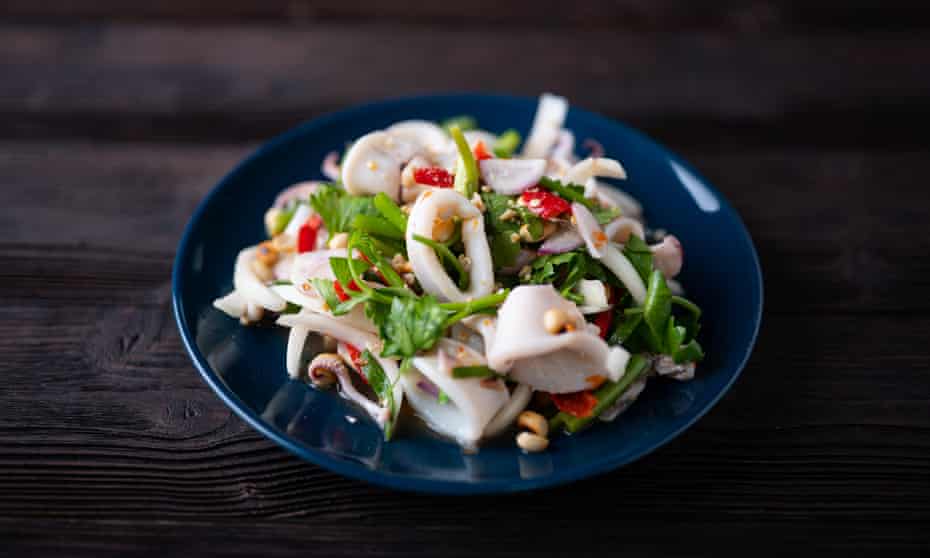Chillies come in such a bewildering array of shapes and colours these days that it doesn’t pay to be too specific: if a recipe calls for a particular sort, you are bound to be unable to find it. In any case, the difference between any two chillies is largely a matter of heat, and heat is largely a matter of taste. So forget about size or colour (green ones are generally hotter than red, but then they turn red anyway if you leave them sitting about) or intimidating varietal names such as yellow death-inducing toxin. Just taste one. If it’s not hot enough, use two or three. If it’s too hot, scrape out the seeds and, specifically, the white membrane they’re attached to, which is the hottest bit.
The most obvious thing to make with chilli is probably chilli, and the least obvious person to rely on for a solid, no-nonsense chilli con carne recipe is probably Heston Blumenthal. Nevertheless, I make his version almost exclusively. While it’s about as fussy as you’d imagine, it’s also pretty forgiving. The fragata pimiento piquillo peppers he tells you to add at the end, for example: I never have any – I don’t even really know what they are – so I just skip that bit, and it’s fine. The spiced butter is the most labour-intensive aspect, and the most counterintuitive, containing as it does ketchup, marmite, Worcestershire sauce and, well, butter. But it makes all the difference.
If you’re trying to make the vegetarian version, chilli sin carne, Felicity Cloake has a very good version, which also contains a bit of Marmite, and coffee.

Allegra McEvedy’s tom yum soup is very much one of those “according to taste” dishes, and you’ll probably only realise how much chilli is too much once you’ve made it a few times and gone too far at least once. When you’ve got your preferred proportions, though, you can produce the base paste in bulk and store it in a jar in the fridge. Meera Sodha’s onion and chilli ramen is another comforting broth with enough heat to keep you on your toes.
This chilli and lime squid salad from James Martin makes for a quick starter, apart from the bit where you marinate the squid overnight. But anything over an hour will do if you lack that sort of foresight regarding tomorrow’s lunch.
Hugh Fearnley-Whittingstall’s stewed red peppers with chorizo offers up a thoroughly warming option that can be on your plate in 40 minutes or so, while Yotam Ottolenghi’s aubergines with charred chilli salsa uses milder chillies which have been blackened a little, and aubergines which have been steamed rather than fried or baked.

Chef Naved Nasir of the Dishoom restaurant chain has a chilli chicken recipe that sounds like the perfect answer to the question, “What shall I do with those boneless chicken thighs that are sitting in the fridge causing me to lose heart?” Marinate them, deep-fry them and toss them in a sauce made from chilli, ginger, garlic and soy.
The now ubiquitous piri piri chicken is actually named after a particularly hot chilli, but Cloake suggests a recipe in which any sufficiently pungent substitute, including the more widely available bird’s eye chillies, will suffice. The resulting chilli sauce is then brushed on the chicken while grilling.
Andi Oliver’s slow-cooked Cubano pork belly requires yet another overnight marinade in chillies, this time blitzed with orange, lime and grapefruit juices, and then cooked low and slow. The whole thing takes about 14 hours, and for most of that time absolutely nothing is required of you.
Chilli is a key ingredient in many pasta dishes, not least the classic – and deeply basic – spaghetti aglio e olio. A lot of recipes use dried chillies (perhaps because it’s meant to be a store cupboard effort) but here’s one from Giorgio Locatelli that doesn’t. He recommends scotch bonnet chillies, but, again, bird’s eye chillies will do. They should be red, though, if only for the colour. Spaghetti with prawns, chilli and rocket is a slightly more elegant variation on this theme.
A lot of the chilli in my life comes in the form of store-bought condiments: those faintly exotic sauces that people give you for Christmas when imagination fails them. Last year, I got on the front foot and gave chilli sauce to everybody before they could give it to me, but it all ended up on the same shelf – half a dozen bottles of fiery red gloop.
You could start 2021 by making your own chilli condiments. Here are two: a chilli jam made with tomatoes and ginger and a fermented chilli sauce from Tom Hunt, which also makes use of the chilli plant’s leaves.

Chilli vodka is just about the easiest thing you can do to preserve a chilli’s heat for the future: slice chillies open, add to vodka, leave. There are some further steps if you want to decant the result into smaller bottles to give as gifts, but you can replace that whole section with the words “drink immediately”.
Let’s finish with two chilli puddings. First, a simple lime and chilli sorbet – it’s about half a kilo of sugar dissolved in 750ml of simmering water, along with six to eight limes and half a chilli, or perhaps a whole one, depending. If you haven’t got an ice-cream maker then freeze the resulting syrup for three hours, stirring it every hour.
Finally, pretend you’re having a dinner party by making this unpardonably show-offy espresso, chocolate and chilli cake with coffee cream. Again, any available variety should work here, although yellow death-inducing toxin is probably not considered a dessert chilli.
from Lifestyle | The Guardian https://ift.tt/3p7n5QQ
via IFTTT

comment 0 Comment
more_vert